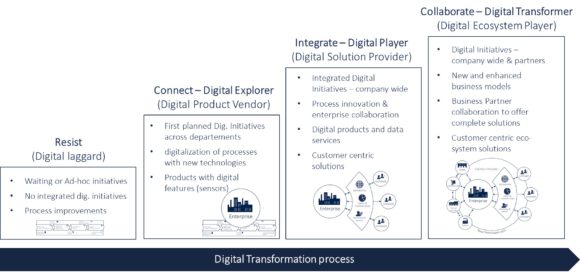Companies have no choice but to digitalize if they want to remain competitive. Many companies have understood this and acted accordingly. Often, however, this takes place in isolation and without any strategic basis within the company organization.
Analysts IDC project that up to 70% of these isolated digital transformation projects will fail over the next two years. So how can you ensure a successful and sustainable digital transformation?
The first step
Before the digital journey can begin, there needs to be a very clear decision as to its location: Where exactly is my company on the digital map? This includes the important question of whether the necessary “digital capabilities” are available for the current position and further developments.
According to IDC, more than 65% of companies currently find themselves in the first “Connect” step of the digital maturity model: processes are being digitalized and partially fitted out with innovative technologies. Examples of this are the use of mobile devices for the approval of orders or vacation requests or the use of wearables in the warehouse. Frequently, however, necessary parallel capabilities such as a corresponding arrangement of organization, leadership, architecture and technology are insufficiently or not at all addressed. In these cases, the level of digital maturity of the company is not able to progress towards the second “Integration” and third “Collaboration” steps and/or leads to the failure or termination of the digital initiatives.
What next?
In addition to developing the necessary digital capabilities, the customer focus for products and solutions is a central precondition for the next digital step: “Integration”. It is not enough to merely upgrade the products to be digital – the focus must instead be on integrating the product and further services into a customer solution. One example of this is a system which detects an error during operation and independently reports the defect to the machine manufacturer’s virtual service platform via sensors. The platform then automatically triggers a repair order and dispatches a service employee. This means that the customer receives rapid and efficient support.
During the fourth and last digital development step, “Collaboration”, the company becomes the provider and manager of a digital ecosystem which supplies the customer solution via a virtual network of various partners. This step no longer involves evolutionary improvements, but rather a radical change of business models.
Mastering the digital transformation
Any company that wants to successfully guide its digital transformation requires guidelines, or even a model, which not only includes all of the steps of the digital journey, but also takes the technologies and digital abilities to be used into consideration, as well as the three central levers of the digital transformation:
- Increasing efficiency, agility and flexibility in the value chain
- Forming the customer approach as well as the customer experience from the first information searches to the purchasing process
- New business models, products and services
In future posts, I will present such a transformation model and explain how you can also achieve evolutionary improvements in your company architecture alongside revolutionary solutions at the business model level.


